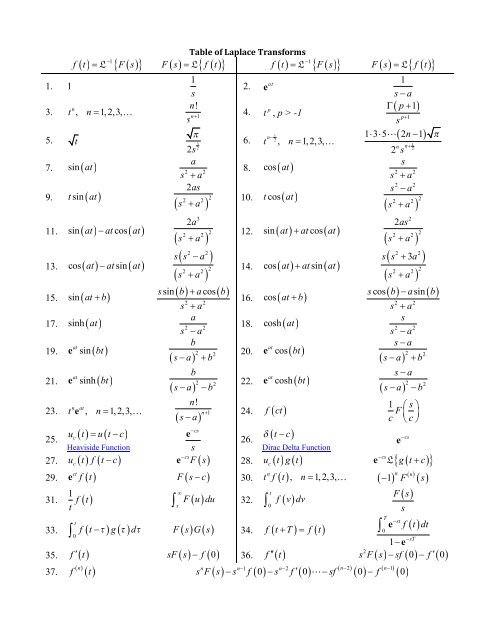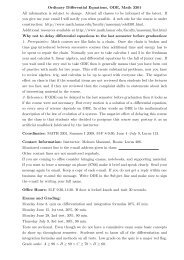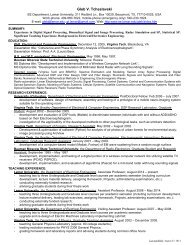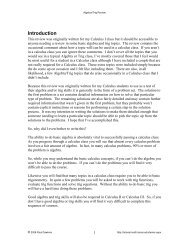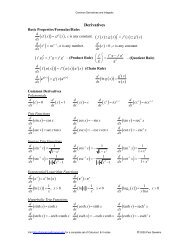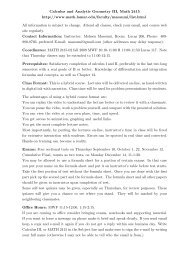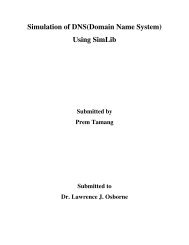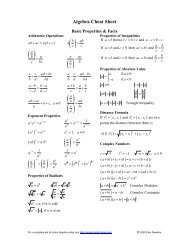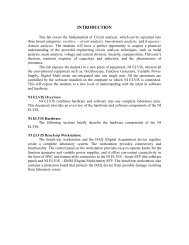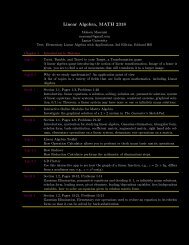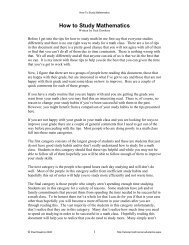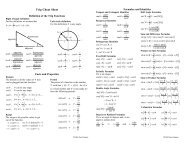Table of Laplace Transforms
Table of Laplace Transforms
Table of Laplace Transforms
Create successful ePaper yourself
Turn your PDF publications into a flip-book with our unique Google optimized e-Paper software.
<strong>Table</strong> <strong>of</strong> <strong>Laplace</strong> <strong>Transforms</strong><br />
-<br />
f t<br />
f t<br />
-<br />
( ) = L F( s)<br />
F( s) = L ( )<br />
( ) = L F( s)<br />
F( s) = L f ( t)<br />
f t<br />
1 { }<br />
{ }<br />
1. 1<br />
1<br />
s<br />
2.<br />
at<br />
e<br />
3.<br />
n<br />
t , n= 1,2,3, K<br />
n!<br />
n 1<br />
s + 4. p<br />
t , p > -1<br />
5. t 3<br />
2s 2<br />
a<br />
7. sin ( at )<br />
2 2<br />
s + a<br />
2as<br />
9. tsin<br />
( at )<br />
2 2<br />
s + a<br />
11. sin( at) - atcos( at)<br />
13. cos( at) - atsin<br />
( at)<br />
p<br />
( ) 2<br />
2a<br />
3<br />
2 2<br />
2<br />
( s + a )<br />
2 2<br />
s( s -a<br />
)<br />
2 2<br />
2<br />
( s + a )<br />
ssin<br />
15. sin ( at+ b)<br />
( b) + acos( b)<br />
2 2<br />
s + a<br />
a<br />
sinh at<br />
2 2<br />
s - a<br />
b<br />
at<br />
e sin bt<br />
s- a + b<br />
17. ( )<br />
19. ( )<br />
at<br />
21. e sinh ( bt)<br />
23. n at<br />
t e , n= 1,2,3, K<br />
25. u ( t c ) = u ( t - c )<br />
Heaviside Function<br />
( ) 2 2<br />
b<br />
( ) 2 2<br />
s-a -b<br />
n!<br />
n<br />
( s-<br />
a ) + 1<br />
-cs<br />
e<br />
s<br />
-cs F s<br />
6.<br />
t<br />
n-<br />
8. ( )<br />
1 { }<br />
1<br />
2<br />
, n= 1,2,3, K<br />
1<br />
s-<br />
a<br />
G p + 1<br />
( )<br />
p 1<br />
s +<br />
{ }<br />
( n )<br />
135 ⋅ ⋅ L 2 -1<br />
1<br />
2 n n +<br />
s 2<br />
s<br />
cos at<br />
2 2<br />
s + a<br />
2 2<br />
s - a<br />
tcos<br />
at<br />
2 2<br />
s + a<br />
10. ( )<br />
12. sin( at) + atcos( at)<br />
14. cos( at) + atsin<br />
( at)<br />
( )<br />
2as<br />
2<br />
2<br />
2 2<br />
2<br />
( s + a )<br />
2 2<br />
( + 3a<br />
)<br />
2 2<br />
2<br />
( s + a )<br />
s s<br />
scos<br />
16. cos( at+ b)<br />
( b) - asin<br />
( b)<br />
2 2<br />
s + a<br />
s<br />
cosh at<br />
2 2<br />
s - a<br />
s-<br />
a<br />
at<br />
e cos bt<br />
s- a + b<br />
18. ( )<br />
20. ( )<br />
at<br />
22. e cosh ( bt)<br />
24. f ( ct )<br />
d<br />
26.<br />
( t-<br />
c)<br />
Dirac Delta Function<br />
( ) 2 2<br />
s-<br />
a<br />
( ) 2 2<br />
s-a -b<br />
1 Ês<br />
ˆ<br />
F Á ˜<br />
c Ëc¯<br />
-cs<br />
27. uc<br />
( t) f ( t- c)<br />
e ( ) 28. uc<br />
( t) g( t )<br />
e L g( t+<br />
c)<br />
29. ct n<br />
(<br />
e f ( t)<br />
F( s- c)<br />
30. t f ( t), n= 1,2,3, K ( 1)<br />
n n<br />
- F )<br />
( s)<br />
•<br />
t<br />
F<br />
Ú F( u)<br />
du 32. Ú f ( v)<br />
dv<br />
( s)<br />
1<br />
31. f () t<br />
t<br />
s<br />
t<br />
33. Ú f ( t-t) g( t)<br />
dt<br />
F( s) G( s ) 34. f ( t T) f ( t)<br />
0<br />
0<br />
-cs<br />
e<br />
{ }<br />
s<br />
+ =<br />
T<br />
-st<br />
Ú e f () t dt<br />
0<br />
-sT<br />
1-<br />
e<br />
t<br />
sF 2 s -sf 0 - f¢ 0<br />
35. f¢ ( t)<br />
sF( s) - f ( 0)<br />
36. f¢¢ ( )<br />
( ) ( ) ( )<br />
( n<br />
37. ) n n-1 n- 2<br />
( n 2<br />
f ( t )<br />
( ) ( ) ( )<br />
) ( n 1<br />
sF s -s f 0 -s f¢<br />
0 L -sf - ( 0)<br />
- f<br />
- )<br />
( 0)<br />
p
<strong>Table</strong> Notes<br />
1. This list is not a complete listing <strong>of</strong> <strong>Laplace</strong> transforms and only contains some <strong>of</strong><br />
the more commonly used <strong>Laplace</strong> transforms and formulas.<br />
2. Recall the definition <strong>of</strong> hyperbolic functions.<br />
e + e e -e<br />
cosh() t = sinh () t =<br />
2 2<br />
t -t t -t<br />
3. Be careful when using “normal” trig function vs. hyperbolic functions. The only<br />
difference in the formulas is the “+ a 2 ” for the “normal” trig functions becomes a<br />
“- a 2 ” for the hyperbolic functions!<br />
4. Formula #4 uses the Gamma function which is defined as<br />
If n is a positive integer then,<br />
x t 1<br />
() • - -<br />
G t = Ú e x dx<br />
0<br />
( n )<br />
G + 1 = n!<br />
The Gamma function is an extension <strong>of</strong> the normal factorial function. Here are a<br />
couple <strong>of</strong> quick facts for the Gamma function<br />
( p 1) p ( p)<br />
G + = G<br />
Ê1ˆ<br />
G Á ˜=<br />
Ë2¯<br />
( p n)<br />
( p)<br />
G +<br />
p( p+ 1)( p+ 2) L ( p+ n- 1)<br />
= G<br />
p


